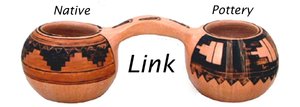
Navajo Pottery
Samuel Manymules was born in 1963, of the Bitterwater Clan for the Red House Clan. (He occasionally refers to himself as “Leumas” Manymules, a reversed spelling of Samuel.) He claims to have taught himself potting by looking at the pottery of Joseph Lonewolf and Christine McHorse in books. He creates minimalist pottery which has an appealing sense of form.
Pi95 Navajo Samuel Manymules open bowl with kiva cut. 5 1/2" x 6"
$365.00
Manymules is a superb potter whose work is growing in popularity. This work by him differs from much of his other work in the color of the outcome, which appears not to be finished with pinon pitch. It also employs a classic kiva design element absent from his swirled pots.
He demonstrates the continuing movement of Navajo pottery to more sophisticated forms and more refined finishes. His pots have been difficult to find on the Navajo reservation, requiring a lot of travel and research to locate his work. Awards recognizing Samuel’s talent is relieving that difficulty.
Samuel Manymules was born in 1963, of the Bitterwater Clan for the Red House Clan. (He occasionally refers to himself as “Leumas” Manymules, a reversed spelling of Samuel.) He claims to have taught himself potting by looking at the pottery of Joseph Lonewolf and Christine McHorse in books. He creates minimalist pottery which has an appealing sense of form.
5.5" x 6" #Pi95
Please Note: For a limited time, our normal fee for packing and shipping this pot will be absorbed by Native-PotteryLink, resulting in FREE SHIPPING to any address within the 48 mainland United States. Shipping to other destination may be arranged by emailing Sanibelart@gmail.com.
See Additional Info for a video of Samuel Manymules explaining his "Perfect World" pot at Indian Market and to read his own words about his approach to potting.




